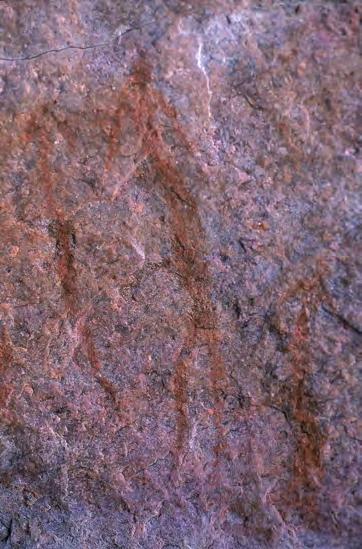
9 minute read
Rock Art in Mozambique: Hunter-Gatherers’ Space, Symbolism, and Tools Décio Muianga
Rock Art in Mozambique
Hunter-Gatherers’ Space, Symbolism, and Tools
Advertisement
Décio Muianga
Décio Muianga is a Mozambican archaeologist trained in Stone Age and rock art studies. He is afliated to the University Eduardo Mondlane, Maputo (Mozambique) and Kaleidoscopio (Independent Research Institute in Public Policy and Culture, Maputo,Mozambique).
Mozambican prehistoric past is largely unknown to the public inside the national borders; so is the past huntergatherer s, notably the Later Stone Age ar tefacts (40 000 BP to recently, 100 years ago – AD) and the associated rock art (paintings and engravings) recognized as the main material features of these populations in souther n Africa. This paper concentrates on the hunter-gatherers’ rock art archaeological signature in Mozambique and the relevance for the study of Later Stone Age (LSA) landscape occupation.
Hunter-gatherers in Mozambique
Mozambique constitutes a link between southern and eastern Africa, and forms the southern extension of the Rift Valley where the valuable and oldest archaeological and anthropological finds of the process of human evolution were discovered. Although there are more than 200 excavated sites associated with the Stone Age in Mozambique, detailed studies regarding the hunter-gatherer period are lacking (Meneses, 1988). Indeed, most archaeological researches have focused on routes of Iron Age migrations on the territory (Adamowicz, 1987; Meneses, 1995, 1999; Smith, 1995; Saetersdal, 2004; Macamo, 2006; Huffman, 2007; Muianga, 2013; Zubieta, 2016). Mozambique has evidence of occupation by two hunter-gatherers’ cultures distinguished by their material culture and rock ar t assemblages. From Zambia to Malawi, the LSA assemblages and rock art on both banks of the Zambezi River have distinctive characteristics that have been extensively studied over the past decades of research. South margin of the Zambezi River (Manica province in Central Mozambique – Fig. 1), Southern Africa is dominated by figurative rock art (fine-line naturalistic images), either painted or engraved.
This tradition shows regional variability in the techniques and in the repertoire of the humans and
Figure 1: Chinhamapere site, Manica Distric, Manica province (Photo: Décio Muianga).

animals depicted (Lewis-Williams, 1981; Garlake, 1995; Dowson, 1998; Saetersdal, 2004; Smith, 2006, 2013; Nhamo, 2007; Blundell et al., 2010). It is associated with the Robberg (18 000-12 000 BP), Oakhurst (12 0007 000 BP), Wilton (8 000-4 000 BP), and final LSA (4 000 BP-100 AD) assemblages that are rich in small scrapers, backed microlithic (especially segments, backed points, bladelets, etc.), ornaments (ostrich eggshell beads), polished bone tools, wood and shell artefacts (Deacon, 1984; Lombard et al., 2012; Dusseldorp et al., 2013). The Wilton technocomplex is present in different types of environments that vary from arid deser t through s e m i a r i d , t h o r nve l d , bu s h ve l d , s ava n n a , r i ve r i n e woodland, and high mountains. On the other side, the northern area of the Zambezi is characterized by geometric rock art traditions – (Clark, 1959; Phillipson, 1977; Juwayeyi, 1981; Juwayeyi & Phiri, 1992; Smith, 1997) with the prevalence of geometric forms (Fig. 2.). In central Africa, Smith distinguishes between Red Animal [male associated – animal depictions are very rare and take bizarre and varied stylised forms (the stomach of the animals is hugely exaggerated and the limbs dwarfed or omitted altogether)] and Red Geometric [female associated – comprised by various red monochrome or red and white bichrome geometric motifs were circles and concentric are very common] traditions (Smith, 1997, 2006, 2013). So far, all of the rock art found in northern Mozambique – in Tete, Nampula and Niassa provinces – conforms to the red geometric rock-art style; so does rock art in Malawi and Zambia. Thus, fine-line tradition has been assigned to the San southern Africa hunter-gatherers’ populations, whereas the red geometric traditions have been attributed to another population of hunter-gatherers’ in the woodlands of south central Africa named the BaTwa. The dominant hunter-gatherers material culture is the Nachikufan technological complex (18 000 to 9 000 BP is Nachikufan I, Nachikufan IIa and IIb are argued to date to between 9 000 and 5 000 BP, and Nachikufan III to extend from 5 000 to 100 BP), representative for south central Africa in general and especially Zambia (Clark, 1950; Miller, 1971; Musonda, 1983; Fletcher, 2010). The Zambian sequence of the microlithic industry is one of the best known in sub-Saharan Africa (Sampson, 1974;

2a)

2b)

Figure 2: a) Red geometric images from Chicolone site (CHC), Tete province; b) San Human figures CIH site – north Zambezi, Tete province (Images reproduced with permission from the archive of the Rock Art Research Institute, University of the Witwatersrand, South Africa, www.sarada.co.za).
Phillipson, 1977; Fletcher, 2010). The majority of Nachikufan sites are located in rock shelters within woodlands (e.g. Muchinga Escarpment), suggesting dependence on hunting of small animals and gathering wild fruits, roots, and nuts. Residents of the Nachikufan sites used bow and arrow technology with transverse heads of stone and points of bone, stone headed knobkerries and later introduced polished stone axes as weapons (Clark, 1959; Fletc her, 2010). The large quantities of tools such as heavy and hollow scrapers, weighted digg ing-stic ks, g r indstones, pestles and spokeshaves (possibly made from polished adzes), may suggest extensive woodworking in northern and eastern Zambia (Clark, 1950; Juwayeyi, 1981; Musonda, 1983; Fletcher, 2010).
Current research
On the basis of existing research in Mozambique, the Zambezi River represented a border or frontier that separated two traditions of hunter-gatherers’ rock art and also two technological complexes. Both LSA and huntergatherers’ rock art in Mozambique are marked with regional variability and this can be explained by the difference of ecosystems and availability of raw materials. However, recent findings (Muianga, 2013) and current research yield evidence of fine-line paintings of San groups in the northern margin of the river (Fig 2.) and instances of the Red Geometric tradition of BaTwa groups on the southern bank with elements of both rock art traditions mixed. Both hunter-gatherers’ populations operated in the riverine, which can now be considered as a permeable frontier for the hunter-gatherer groups, with links or possible signs of interaction between the San and BaTwa now identified in central Mozambique. Indeed, few examples from central Mozambique demonstrate that interaction between the hunter-gatherer populations resulted in the absorption of stylistic elements in the depiction of the paintings on both sides of the river by the two groups here described. Still, these types of paintings remain rare and further investigation is needed on the topic. From a static point of view, the Zambezi River is not a classic case of a border area where a physical boundary separates two g roups. The Zambezi was definitely accessible and easy to cross by both groups, but the cultural boundary was moveable and influenced the intervenient of these interactions to produce a more hybrid rock art – a matter that requires further studies. The study of hunter-gatherers rock art and associated material culture identified in Mozambique is an effor t to understand the complexities of past African minds and ancient societies that explored diverse geographical spaces and ecosystem’s shaping thus the rich prehistoric cultural landscapes of the Sub Saharan section of the continent.
Bibliography
ADAMOWICZ, L., 1987, ‘“Projecto Cipriana”, 1981-1985: Contibuição Para o Conhecimento Da Arqueologia Entre Os Rios Lúrio e Ligonha, Província de Nampula’, Trabalhos de Arqueologia e Antropologia, 3, p. 47–144. BLUNDELL, G., CHIPPINDALE, C., SMITH, B., 2010, Seeing and Knowing: Understanding Rock Art with and without Ethnography, Johannesburg, Wits University Press. CLARK, J.D., 1950, “The Newly Discovered Nachikufu Culture of Northern Rhodesia and Possible Origin of Certain Elements of the South African Smithfield Culture”, South African Archaeological Bulletin, 5, p. 86–98. CLARK, J. D., 1959, The Prehistory of Southern Africa, Harmondsworth, Penguin Books. DEACON, J., 1984, The Later Stone Age of Southernmost Africa, Oxford, B.A.R. DOWSON, T.A., 1998, “Rain in Bushmen Belief, Politics and History: The Rock Art of Rain-Making in South-Eastern Mountains, Southern Africa”, in C. CHIPPENDALE, P.S.C. TAÇON (ed.), The Archaeology of Rock Art, Cambridge, Cambridge University Press, p. 73–89. DUSSELDORP, G., LOMBARD, M., WURZ, S., 2013, “Pleistocene Homo and the Updated Stone Age Sequence of South Africa”, South African Journal of Science, 109(5/6), p. 1–7. FLETCHER, R.J., 2010, Seeking Social Identity in the Later Stone Age: Techniques and Technical Choice within the Mid Late Holocene Microlithic Industries in Zambia, PhD dissertation, Liverpool, University of Liverpool.
crossed views from southern africa
GARLAKE, P.S., 1995, The Hunter’s Vision: The Prehistoric Art of Zimbabwe, London, British Museum Press. HUFFMAN, T.N., 2007, Handbook to the Iron Age: The Archaeology of Pre-Colonial Farming Societies in Southern Africa, Pietermaritzburg, University of KwaZulu-Natal Press. JUWAYEYI, Y., 1981, The Later Prehistory of Southern Malawi: A Contribution to the Study of Technology and Economy during the Later Stone Age and Iron Age Periods, PhD dissertation, Berkeley, University of California. JUWAYEYI, Y., PHIRI, M.Z., 1992, “The State of Rock Art Research in Malawi”, Occasional Papers of the Malawi Department of Antiquities, 1, p. 53–66. LEWIS-WILLIAMS, J. D., 1981, Believing and Seeing: Symbolic Meanings in Southern San Rock Paintings, London, New York Academic Press. LOMBARD, M., WADLEY, L., DEACON, J., WURZ, S., PARSONS, I., MOHAPI, M., SWART, J., MITCHELL, P., 2012, “South African and Lesotho Stone Age Sequence Updated (I)”, The South African Archaeological Bulletin, 67(195), p. 123–44. MACAMO, S., 2006, Privileged places in south central Mozambique: the archaeology of Manyikeni, Niamara, Songo and Degue-Mufa, Maputo, Uppsala University. MENESES, M.P., 1988, “Idade Da Pedra Em Moçambique (Os Primórdios Da Sociedade Humana: Evidências Arqueológicas)”, Trabalhos de Arqueologia e Antropologia, 5, p. 3–56. MENESES, M.P., 1995, “Some Aspects Regarding the Acheulean in Southern Mozambique”, in G. PWITI, R. C. SOPER (ed.), Aspects of th African Prehistory: Papers from the 10 Congress of the PanAfrican Association for Prehistory and Related Studies, Harare, University of Zimbabwe Publications, p. 129–137. MENESES, M.P., 1999, New Methodological Approaches to the Study of the Acheulean from Southern Mozambique, PhD dissertation, Rutgers, The State University of New Jersey. MILLER, S.F., 1971, “The Age of Nachikufan Industries in Zambia”, The South African Archaeological Bulletin, 26(103/104), p. 143–46. MUIANGA, D.J.D., 2013, Rock Art and Ancient Material Culture of Cahora Bassa Dam, Tete Province, Mozambique, Master dissertation, Johannesburg, University of the Witwatersrand. MUSONDA, F.B., 1983, Aspects of the Prehistory of the Lunsemfwa Drainage Basin, Zambia, During the Last 20,000 Years, PhD dissertation, Berkeley, University of California. NHAMO, A., 2007, Out of the Labyrinth: The Signicance of Kudu Images in the Rock Art of Zimunya, Harare, University of Zimbabwe Publications. PHILLIPSON, D. W., 1977, The Later Prehistory of Eastern and Southern Africa, London, Heinemann. SAETERSDAL, T.W., 2004, Places, People and Ancestors: Archaeology and Society in Manica, Mozambique, Bergen, Faculty of Arts, University of Bergen. SAMPSON, C.G., 1974, The Stone Age Archaeology of Southern Africa, New York, Academic Press. SMITH, B.W., 1995, Rock Art in South-Central Africa: A Study Based on the Pictographs of the Dedza District, Malawi and Kasama District, Zambia, PhD dissertation, Cambridge, University of Cambridge. SMITH, B.W., 1997, Zambia’s Ancient Rock Art: The Paintings of Kasama, National Heritage Conservation Commission. SMITH, B.W., 2006, “Rock Art and Writing Genetic History: Regionalism, Ethnicity and the Rock Art of Southern Africa”, in H. SOODYALL (ed.), The Prehistory of Africa: Tracing the Lineage of Modern Man, Jeppestown, Jonathan Ball Publishers, p. 76–96. SMITH, B.W., 2013, “Rock Art Research in Africa”, in P. MITCHELL, P.J. LANE (ed.), The Oxford Handbook of African Archaeology, Oxford, Oxford University Press, p. 145–61. ZUBIETA, L. F., 2016, “Learning through Practise: Cheŵa Women’s Roles and the Use of Rock Art in Passing on Cultural Knowledge”, Journal of Anthropological Archaeology, 43, p.13–28.










